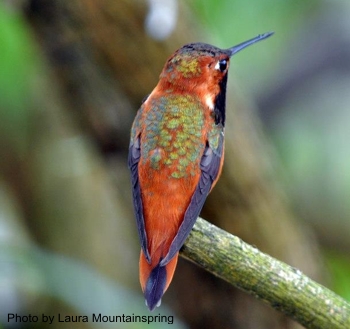HUMMINGBIRDS IN DOUGLAS COUNTY, OREGON
Hummingbird Identification
•Sherri Williamson's "Hummingbirds of North America" (a Peterson Field Guide)
•Steve Howell's "Hummingbirds of North America: The Photographic Guide."
Commonly Seen Hummingbirds
This fiesty hummingbird typically arrives in the lowlands here in mid-February. Males especially are quite fiesty and make quite a bit of noise when attempting to run off competition at a hummingbird feeder or a favored patch of flowers. Numbers increase as the season progresses and then decrease again as birds leave our area. Adult males are unmistakable with their bright rufous plumage, while females may be more easily confused with other female hummingbirds. Practice and study, however, enables them to be distinguished. The Rufous occurs throughout the Umpqua Basin, from dune shrublands to timberline in the Cascades.
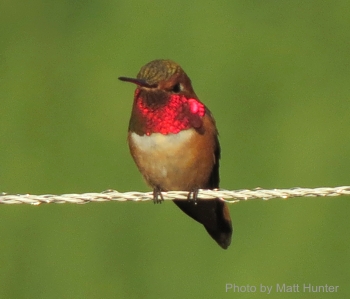
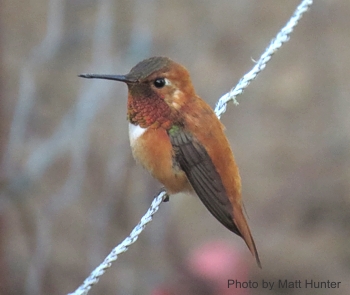
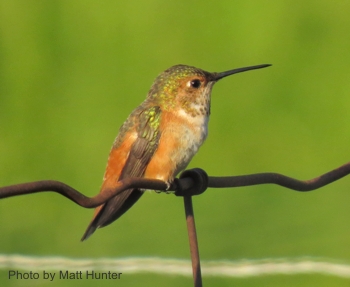

Anna's Hummingbirds were first detected in Oregon in the 1940s. Since then they have continued to expand their range north and have become quite common and, unlike the Rufous Hummingbird, the Anna's Hummingbird is present all year long. The range of occurrence of the Anna's, however, is more limited than the Rufous. Anna's are most common at low elevations, especially in urban areas with high plant diversity and plenty of hummingbird feeders. They also occur in many other open and especially shrubby areas at low elevations in the basin, and occur in to the Cascades at low elevations along the major river and stream corridors. Their precise range is not well known in the county, and they may continue to expand, so documenting and reporting sightings of this species will help us to better understand what this hummingbird is doing in our basin.
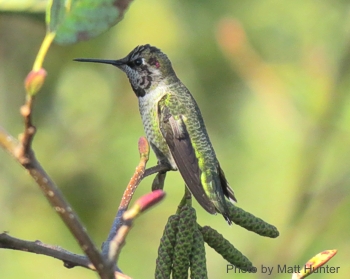
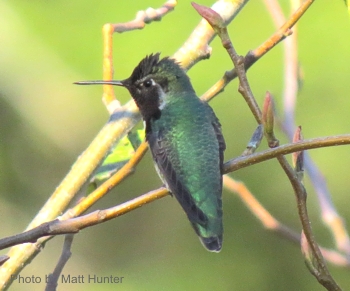
Rare Hummingbirds
This tiny hummingbird is presumed to breed in small numbers in the Cascades, so the species is not extremely rare or unexpected here, but their numbers are exceedingly small and the appearance of a Calliope at a feeder or the discovery of one in a mountain meadow or brushfield is worthy of note and sharing. In the past, a dozen or more males could be found displaying in Thorn Prairie, east-northeast of Toketee Lake in the Umpqua National Forest. Poor management there destroyed their habitat, but hopefully recent restoration efforts will bring the species back. Otherwise, the species is presumed to breed in small numbers in high mountain meadows, but there is little evidence to support this probably correct assumption. At lower elevations Calliope Hummingbirds show up nearly annually at residential nectar feeders, typically in late April and the first half of May, and just one or two reports each spring.
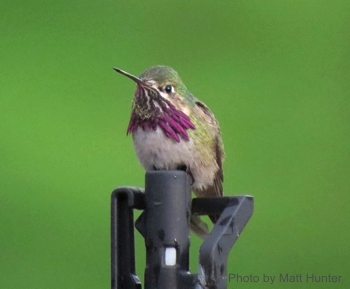
Costa's is primarily a hummingbird of the desert southwest. Records from Oregon include sightings from all seasons. Currently about one or two are observed in Oregon each year. The males are the most obvious, with their bluish-purple, very extended gorgets, bright white throat, and thin pale stripe down the center of the breast/belly. Females are much less conspicuous and require great care to distinguish from female Anna's and Black-chinned Hummingbirds as well as the extremely rare Ruby-throated Hummingbird. There are at least 3 photo documented records of this species in Douglas County and several additional reports.
The bird in the photo to the right visited Ronne Vaughn's yard and feeder during the summer of 2012 in south Roseburg.

Black-chinned hummers are present in small numbers in eastern Oregon during spring and summer. Records in western Oregon are few. Males are fairly obvious with their black and purple gorgets and very green backs. Females require great care to distinguish from female Anna's and Black-chinned Hummingbirds, as well as the extremely rare Ruby-throated Hummingbird. There are at least three photographically documented records of the species in Douglas County (see below and right), and a small number of other sight reports.
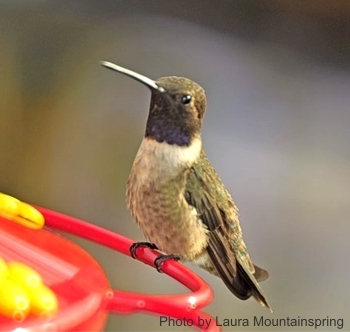
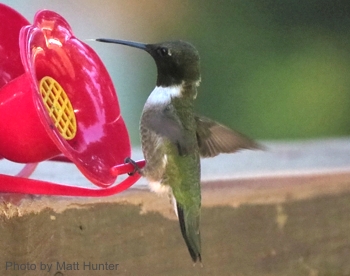
23 August 2013, near Drain, Oregon.
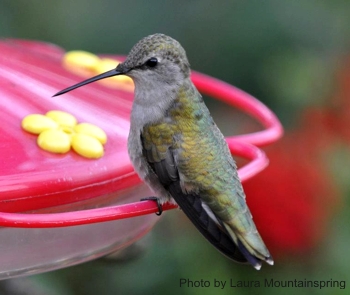
22 May 2012, near Winston, Oregon.
In Oregon, Allen's Hummingbirds are presumed to breed on the southern coast in Curry County and possibly southern Coos County. There are a few verified (in-hand measured and photographed) records from Josephine County by Dennis Vroman and numerous reports from Coos County (see eBird.org), but very few documented records occur outside of Curry County. While there have been a number of sight reports in Douglas County, to my knowledge there are no specimens, photographs, or sound recordings veryifying any of the reports. A lack of awareness as well as misinformation about plumage and flight displays of these species has likely led to many mistaken reports. Nevertheless, it is possible that spring migrants or post-breeding dispersants are present on occasion. The best way to document a possible Allen's (other than specimen or in-hand measurements) is to take photographs of the spread tail (or ask someone else to do so), often easiest at a feeder! If you have found a displaying bird (dive display), try to get a video of the complete display pattern, and/or a recording of the dive sound, at the end of the dive.
•Mike Patterson's Handy Hummer ID Tips
•Mike Patterson's article, Green-backed Selasphorus Hummingbirds in Clatsop County, Oregon.
•Sheri Williamson's article on Rufous vs. Allen's
•Photo galleries with Sheri Williamson's comments on Allen's Hummingbirds and Rufous Hummingbirds of different ages and sexes.
•John Garrett's article on Selasphorus hummingbirds.
•Display dive sounds of Allen's Hummingbird and Rufous Hummingbird from xeno-canto.org.
